The Hand Dryer Market is estimated to be valued at USD 1.9 billion in 2025 and is projected to reach USD 3.8 billion by 2035, registering a compound annual growth rate (CAGR) of 7.0% over the forecast period. A 5-year growth block analysis shows steady expansion, particularly in the early stages. Between 2025 and 2030, the market grows from USD 1.9 billion to USD 2.7 billion, contributing USD 0.8 billion in growth, with a CAGR of 7.4%.
This phase is driven by increasing demand for energy-efficient, hygienic, and environmentally friendly hand drying solutions across public and commercial sectors. The shift towards contactless solutions and heightened awareness of hygiene, particularly post-pandemic, further boosts the demand for hand dryers. As businesses and institutions seek to improve hygiene standards, hand dryers provide a cost-effective and eco-conscious alternative to paper towels.
From 2030 to 2035, the market continues to expand from USD 2.7 billion to USD 3.8 billion, contributing USD 1.1 billion in growth, with a CAGR of 7.1%. This later phase shows moderate acceleration as adoption spreads to emerging markets, and ongoing advancements in technology, such as faster drying times and quieter operations, continue to drive consumer interest. The overall analysis indicates a strong growth trajectory, with a steady rate of adoption driven by both hygiene trends and advancements in hand dryer technology.
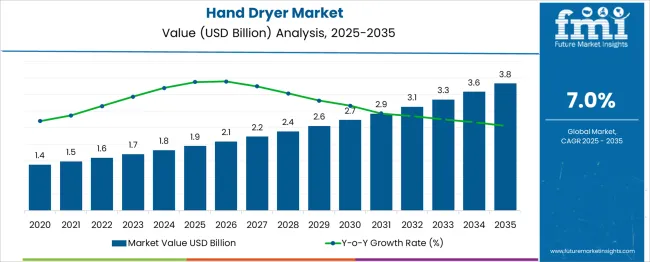
| Metric | Value |
|---|---|
| Hand Dryer Market Estimated Value in (2025 E) | USD 1.9 billion |
| Hand Dryer Market Forecast Value in (2035 F) | USD 3.8 billion |
| Forecast CAGR (2025 to 2035) | 7.0% |
The Hand Dryer market is experiencing significant growth fueled by rising demand for hygiene-focused, energy-efficient, and sustainable hand drying solutions in public and commercial spaces. The current market scenario is marked by increasing awareness of environmental sustainability, which has encouraged businesses to replace paper towels with touchless, low-energy hand dryers.
Investor updates and corporate press releases indicate that regulatory support for green building standards and improved washroom hygiene are further propelling adoption. As noted in industry journals and annual reports, future opportunities are being shaped by innovations in sensor technology, noise reduction, and energy efficiency, which enhance user experience and operational cost savings.
The ability of hand dryers to minimize cross-contamination and reduce waste aligns with evolving public health guidelines and customer preferences. With the ongoing expansion of infrastructure in emerging markets and the emphasis on eco-friendly solutions in developed regions, the Hand Dryer market is poised for continued growth in the years ahead.
The hand dryer market is segmented by type, air type, operations, power, price range, end-use, distribution channel, and geographic regions. The hand dryer market is divided into Wall mount and Surface mount. In terms of air type, the hand dryer market is classified into Hot Air and Cold Air. The hand dryer market is segmented into Automatic and Manual.
By power, the hand dryer market is segmented into 1000W-2000W, Up to 1000W, and Above 2000W. The price range of the hand dryer market is segmented into Mid, Low, and High. The end-use of the hand dryer market is segmented into Commercial and Individual. The distribution channel of the hand dryer market is segmented into Offline and Online. Regionally, the hand dryer industry is classified into North America, Latin America, Western Europe, Eastern Europe, Balkan & Baltic Countries, Russia & Belarus, Central Asia, East Asia, South Asia & Pacific, and the Middle East & Africa.
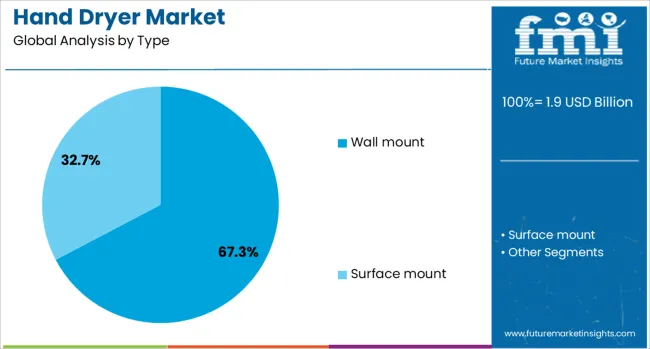
The wall mount type is expected to hold 67.3% of the Hand Dryer market revenue share in 2025, positioning it as the leading type segment. This dominance is being attributed to its space-saving design, ease of installation, and compatibility with a wide range of washroom layouts, as highlighted in product specifications and architectural guidelines.
Wall-mount models have been widely preferred in high-traffic areas due to their ability to maximize floor space and deliver efficient airflow at convenient heights for users. According to corporate statements and technology news, their robust construction and minimal maintenance requirements have further supported their widespread adoption.
The segment’s leadership has also been strengthened by its suitability for retrofitting in existing buildings without significant structural modifications. These benefits, combined with advancements in noise control and power efficiency, have enabled wall-mount hand dryers to remain the most popular choice in commercial and institutional environments.
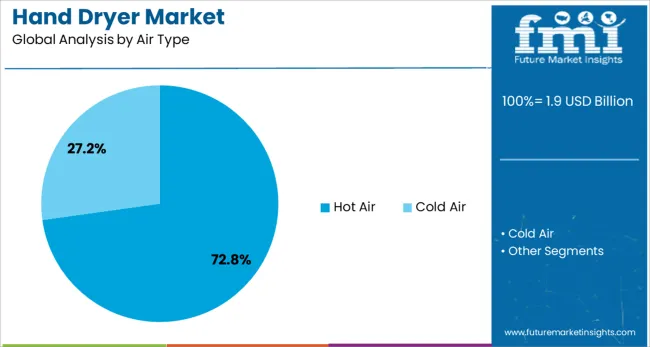
The hot air type is projected to command 72.8% of the Hand Dryer market revenue share in 2025, securing its place as the dominant air type segment. This leading position has been driven by its perceived comfort and effectiveness in drying hands quickly and thoroughly, as noted in customer feedback and corporate product announcements.
Hot air dryers have been adopted extensively in regions with colder climates where warmth is preferred by users. According to facility management journals, this segment has also benefited from the ability to deliver consistent performance even in high-traffic environments.
Technological improvements in heating elements and airflow distribution have minimized energy consumption while maintaining fast drying times, reinforcing its acceptance. Additionally, hot air hand dryers have been favored by facility operators for their relatively lower upfront costs and proven reliability, which have contributed to their continued dominance in the market.
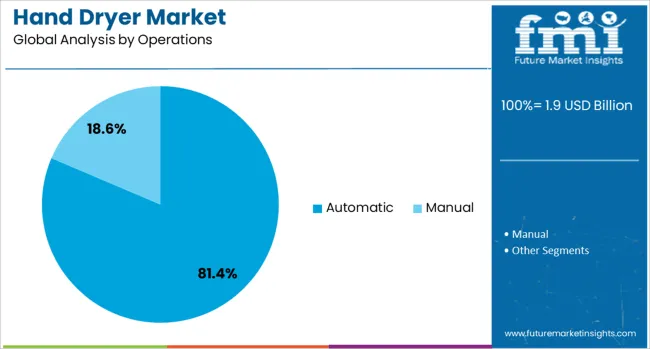
The automatic operations segment is anticipated to account for 81.4% of the Hand Dryer market revenue share in 2025, establishing it as the leading operational mode. This leadership has been underpinned by heightened hygiene awareness and the demand for touchless solutions, as observed in health authority recommendations and corporate sustainability reports.
Automatic hand dryers have been widely implemented to reduce the risk of cross-contamination, aligning with global public health objectives. Industry publications have highlighted that sensor-based operation enhances user convenience and reduces energy waste by operating only when needed.
Facility managers have favored automatic dryers for their ability to lower maintenance costs and improve traffic flow in restrooms, which has further accelerated their adoption. These advantages, together with technological refinements that improve sensor responsiveness and energy efficiency, have ensured the sustained prominence of the automatic segment in the Hand Dryer market.
The demand for hand dryers is increasing due to the growing need for hygienic, cost-effective, and environmentally conscious alternatives to paper towels. These devices offer faster drying times, reduced waste, and lower long-term maintenance costs, making them an appealing choice for businesses and public institutions. Technological innovations, such as high-speed drying and touchless operation, continue to drive product adoption in sectors such as healthcare, hospitality, and retail. Despite challenges like high installation costs and noise concerns, the market presents opportunities through continued product innovation and expanded applications.
The demand for hand dryers is increasingly driven by the need for more efficient and hygienic solutions, particularly in public and commercial spaces. With growing awareness of cleanliness, businesses, airports, hospitals, and restaurants are turning to hand dryers to reduce the spread of germs and improve hygiene. Unlike paper towels, hand dryers offer long-term cost savings by eliminating the need for constant replacement and disposal of paper. These devices also contribute to reducing waste and operational costs, making them more attractive in commercial buildings. Hand dryers are gaining popularity for their ability to provide a quicker, more efficient solution to hand drying, which is especially important in high-traffic areas where speed and convenience matter.
Despite their long-term cost benefits, the high initial installation cost of hand dryers remains a key challenge. The upfront expense, including the cost of the units and installation, can be a significant barrier for smaller businesses, especially when compared to the relatively low cost of paper towels. Additionally, the high-speed hand dryers, although more efficient, often come with higher purchase and maintenance costs, which can deter price-sensitive organizations. Another challenge is the noise levels of these devices, especially high-speed models. In environments where noise is a concern, such as offices, healthcare facilities, and libraries, the loud sound generated by hand dryers can be disruptive to customers and employees, reducing their appeal. Ensuring that hand dryers are consistently maintained and operating at peak efficiency is also vital, as neglected units may lead to user dissatisfaction or higher operational costs over time.
There are significant opportunities in the hand dryer industry, particularly with advancements in technology and the growing demand in emerging markets. The development of smarter hand dryers equipped with sensors, energy-efficient motors, and customizable settings offers a chance for manufacturers to differentiate their products. Smart technologies, such as data collection for maintenance needs, energy monitoring, and remote diagnostic tools, are gaining traction. These innovations provide businesses with tools to optimize their operations and reduce energy consumption. As urbanization accelerates and the construction of commercial buildings increases in regions like Asia-Pacific and Latin America, there is potential for hand dryers to become the standard solution for hygienic hand drying in high-traffic public spaces, presenting a large and untapped market.
A significant trend in the hand dryer market is the increasing adoption of touchless and high-speed models, driven by heightened hygiene concerns and a need for greater efficiency. Touchless hand dryers, which operate without requiring physical contact, are becoming the standard in public restrooms to reduce the risk of cross-contamination and improve user experience. Additionally, the trend towards high-speed dryers, which offer rapid drying times, is gaining traction, especially in high-traffic areas like airports and shopping malls. Consumers and businesses are increasingly seeking products that can deliver performance while using less energy. Another trend is the growing integration of smart features, such as sensor-based monitoring and data collection, to ensure optimal performance and reduce operational costs.
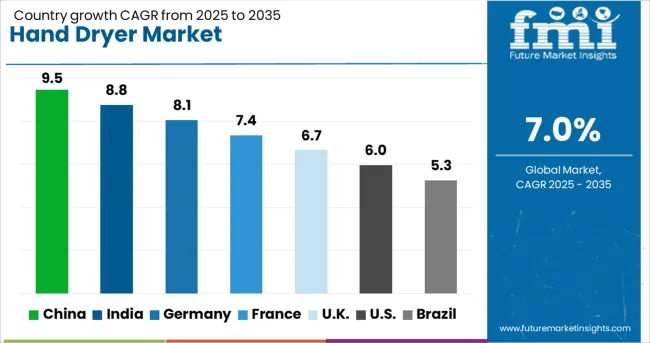
| Country | CAGR |
|---|---|
| China | 9.5% |
| India | 8.8% |
| Germany | 8.1% |
| France | 7.4% |
| UK | 6.7% |
| USA | 6.0% |
| Brazil | 5.3% |
The global hand dryer market is projected to grow at a CAGR of 7.0%, with major contributions from China, India, France, the UK, and the USA China leads with a growth rate of 9.5%, followed by India at 8.8%. France records a growth rate of 7.4%, while the UK and USA show growth rates of 6.7% and 6.0%, respectively. The increasing demand for energy-efficient solutions in public restrooms, driven by awareness of hygiene and waste reduction, is fueling market expansion. Both emerging and developed markets are seeing growth due to advancements in touchless technologies and greater focus on improving public sanitation facilities. The analysis includes over 40 countries, with the top five detailed below.
China is projected to lead the global hand dryer market with a growth rate of 9.5%. Rapid urbanization and a strong focus on infrastructure development are propelling the adoption of hand dryers in both public and commercial spaces. As disposable incomes rise, consumers are increasingly opting for modern, energy-efficient appliances, including hand dryers. Additionally, the government’s focus on modernizing public restrooms and commercial infrastructure provides a boost to the demand. As environmental awareness grows, there is also a shift toward reducing paper waste, further accelerating the demand for hand dryers.
The hand dryer market in India is expected to grow at a CAGR of 8.8%. The market is benefiting from significant infrastructure development in urban and semi-urban areas, where new commercial spaces, airports, and malls are emerging. The growing middle class, coupled with increased health consciousness, is driving the demand for hygienic and efficient hand drying solutions. As more public restrooms are being equipped with modern amenities, including touchless hand dryers, India’s demand for these products is expected to rise. The growing importance of energy efficiency in everyday appliances also supports the market’s growth.
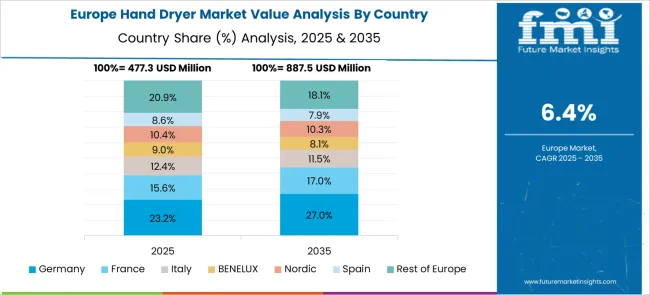
The hand dryer market in France is expected to grow at a CAGR of 7.4%. France has long been a leader in adopting energy-efficient and environmentally friendly solutions, and the hand dryer market is no exception. As the demand for hygiene solutions increases in public restrooms, the shift toward touchless and high-performance dryers is evident. France’s growing focus on reducing waste in public spaces is a key factor in the growing popularity of hand dryers, which are viewed as a more sustainable alternative to paper towels. France’s regulations promoting eco-friendly technologies also support market growth.
The UK is projected to grow at a CAGR of 6.7% in the hand dryer market. The UK has witnessed a rising interest in energy-efficient appliances, particularly in commercial and public spaces. As consumers and businesses focus on reducing waste and improving hygiene, hand dryers have become a preferred choice over paper towels. Increasing demand for touchless technology, driven by health and safety concerns, further supports the market’s growth. Additionally, stringent environmental regulations and growing eco-consciousness among consumers are pushing for the adoption of advanced, energy-efficient hand dryers.
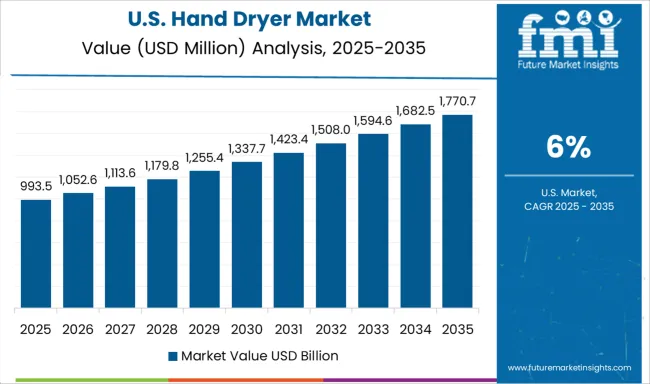
The USA hand dryer market is projected to grow at a CAGR of 6.0%. As consumers become more focused on hygiene, the demand for energy-efficient and touchless hand dryers continues to rise. The USA market benefits from increasing awareness about the environmental impact of paper towels and the associated waste. With the growing emphasis on improving public restroom standards and offering high-performance, hygienic solutions, hand dryers are becoming more prevalent in commercial, public, and institutional facilities. The USA market is also benefiting from innovations in design and functionality, which continue to enhance consumer appeal.
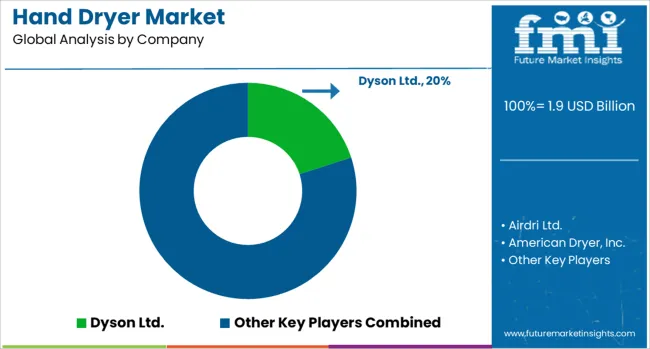
The hand dryer market is driven by leading manufacturers offering advanced solutions for high-speed, energy-efficient, and hygienic hand drying. Dyson Ltd. is a market leader, offering innovative high-performance hand dryers such as the Dyson Airblade, which combines fast drying times with minimal environmental impact. Airdri Ltd. specializes in energy-efficient hand dryers that focus on sustainability and cost-effective solutions for commercial and public washrooms.
American Dryer, Inc. is a key player, providing high-quality, durable hand dryers for both high-traffic and low-energy applications, with an emphasis on robust design and ease of installation. Bobrick Washroom Equipment, Inc. offers a broad range of hand dryers, catering to commercial, industrial, and institutional markets, with a focus on hygiene and reliability.
Bradley Corporation also contributes to the market with high-performance hand dryers designed for heavy-use environments, emphasizing durability, performance, and ease of maintenance. Electrolux offers innovative, energy-efficient hand dryers for commercial spaces, focusing on reduced operational costs and superior hygiene.
Excel Dryer, Inc. is known for its XLERATOR brand, offering high-speed hand dryers that reduce energy consumption while providing quick drying times. Hokwang Industries Co., Ltd. provides a range of eco-friendly and hygienic hand dryers, including both automatic and touchless systems designed for different commercial environments. JVD SAS and Mitsubishi Electric Corporation offer compact, energy-efficient hand dryers, catering to the growing demand for space-saving designs. Palmer Fixture and Saniflow Corporation focus on durable, low-maintenance hand dryers for high-traffic public spaces.
TOTO Ltd. and World Dryer Corporation provide technologically advanced hand dryers, offering features like high-speed drying, hygiene-focused designs, and customizable options for various washroom applications. Competitive differentiation in the hand dryer market is driven by product innovation, energy efficiency, drying speed, hygiene features, and maintenance requirements.
Barriers to entry include high capital investment in R&D, stringent hygiene regulations, and the ability to meet diverse customer needs. Strategic priorities include improving energy efficiency, enhancing drying performance, and expanding product lines to meet evolving hygiene standards and consumer preferences.
| Item | Value |
|---|---|
| Quantitative Units | USD 1.9 Billion |
| Type | Wall mount and Surface mount |
| Air Type | Hot Air and Cold Air |
| Operations | Automatic and Manual |
| Power | 1000W-2000W, Up to 1000W, and Above 2000W |
| Price Range | Mid, Low, and High |
| End-use | Commercial and Individual |
| Distribution Channel | Offline and Online |
| Regions Covered | North America, Europe, Asia-Pacific, Latin America, Middle East & Africa |
| Country Covered | United States, Canada, Germany, France, United Kingdom, China, Japan, India, Brazil, South Africa |
| Key Companies Profiled | Dyson Ltd., Airdri Ltd., American Dryer, Inc., Bobrick Washroom Equipment, Inc., Bradley Corporation, Electrolux, Excel Dryer, Inc., Hokwang Industries Co., Ltd., JVD SAS, Mitsubishi Electric Corporation, Palmer Fixture, Panasonic Corporation, Saniflow Corporation, TOTO Ltd., and World Dryer Corporation |
| Additional Attributes | Dollar sales by product type (high-speed hand dryers, traditional hand dryers, hybrid models) and end-use segments (commercial, industrial, institutional, public washrooms). Demand dynamics are influenced by the growing focus on the need for hygienic solutions in high-traffic areas, and the rise of energy-efficient building standards. Regional trends show strong growth in North America and Europe, driven by increased awareness of hygiene and environmental impact, while Asia-Pacific is expanding due to rising urbanization and commercial infrastructure development. |
The global hand dryer market is estimated to be valued at USD 1.9 billion in 2025.
The market size for the hand dryer market is projected to reach USD 3.8 billion by 2035.
The hand dryer market is expected to grow at a 7.0% CAGR between 2025 and 2035.
The key product types in hand dryer market are wall mount and surface mount.
In terms of air type, hot air segment to command 72.8% share in the hand dryer market in 2025.






Our Research Products

The "Full Research Suite" delivers actionable market intel, deep dives on markets or technologies, so clients act faster, cut risk, and unlock growth.

The Leaderboard benchmarks and ranks top vendors, classifying them as Established Leaders, Leading Challengers, or Disruptors & Challengers.

Locates where complements amplify value and substitutes erode it, forecasting net impact by horizon

We deliver granular, decision-grade intel: market sizing, 5-year forecasts, pricing, adoption, usage, revenue, and operational KPIs—plus competitor tracking, regulation, and value chains—across 60 countries broadly.

Spot the shifts before they hit your P&L. We track inflection points, adoption curves, pricing moves, and ecosystem plays to show where demand is heading, why it is changing, and what to do next across high-growth markets and disruptive tech

Real-time reads of user behavior. We track shifting priorities, perceptions of today’s and next-gen services, and provider experience, then pace how fast tech moves from trial to adoption, blending buyer, consumer, and channel inputs with social signals (#WhySwitch, #UX).

Partner with our analyst team to build a custom report designed around your business priorities. From analysing market trends to assessing competitors or crafting bespoke datasets, we tailor insights to your needs.
Supplier Intelligence
Discovery & Profiling
Capacity & Footprint
Performance & Risk
Compliance & Governance
Commercial Readiness
Who Supplies Whom
Scorecards & Shortlists
Playbooks & Docs
Category Intelligence
Definition & Scope
Demand & Use Cases
Cost Drivers
Market Structure
Supply Chain Map
Trade & Policy
Operating Norms
Deliverables
Buyer Intelligence
Account Basics
Spend & Scope
Procurement Model
Vendor Requirements
Terms & Policies
Entry Strategy
Pain Points & Triggers
Outputs
Pricing Analysis
Benchmarks
Trends
Should-Cost
Indexation
Landed Cost
Commercial Terms
Deliverables
Brand Analysis
Positioning & Value Prop
Share & Presence
Customer Evidence
Go-to-Market
Digital & Reputation
Compliance & Trust
KPIs & Gaps
Outputs
Full Research Suite comprises of:
Market outlook & trends analysis
Interviews & case studies
Strategic recommendations
Vendor profiles & capabilities analysis
5-year forecasts
8 regions and 60+ country-level data splits
Market segment data splits
12 months of continuous data updates
DELIVERED AS:
PDF EXCEL ONLINE
Handheld Electrostatic Meter Market Size and Share Forecast Outlook 2025 to 2035
Hand Towel Automatic Folding Machine Market Size and Share Forecast Outlook 2025 to 2035
Handheld Ultrasound Scanner Market Size and Share Forecast Outlook 2025 to 2035
Handheld Tagging Gun Market Forecast and Outlook 2025 to 2035
Handheld Imaging Systems Market Size and Share Forecast Outlook 2025 to 2035
Hand Tools Market Size and Share Forecast Outlook 2025 to 2035
Handloom Product Market Size and Share Forecast Outlook 2025 to 2035
Handheld XRF Analyzers Market Size and Share Forecast Outlook 2025 to 2035
Handheld Police Radar Guns Market Size and Share Forecast Outlook 2025 to 2035
Handheld DNA Reader Market Size and Share Forecast Outlook 2025 to 2035
Handheld Robotic Navigation Market Analysis - Size, Share, and Forecast Outlook 2025 to 2035
Handheld Mesh Nebulizer Market Size and Share Forecast Outlook 2025 to 2035
Hand & Arm Protection (PPE) Market Size and Share Forecast Outlook 2025 to 2035
Handwheels Market Size and Share Forecast Outlook 2025 to 2035
Handheld Chemical and Metal Detector Market Size and Share Forecast Outlook 2025 to 2035
Hands-Free Safety Tools Market Size and Share Forecast Outlook 2025 to 2035
Hand-held Breast Cancer Detection Market Analysis Size and Share Forecast Outlook 2025 to 2035
Handheld Dental X-Ray Systems Market Analysis - Size, Share, and Forecast 2025 to 2035
Hand Blender Market Size and Share Forecast Outlook 2025 to 2035
Hand Sanitizer Spray Pen Market Size and Share Forecast Outlook 2025 to 2035

Thank you!
You will receive an email from our Business Development Manager. Please be sure to check your SPAM/JUNK folder too.
Chat With
MaRIA